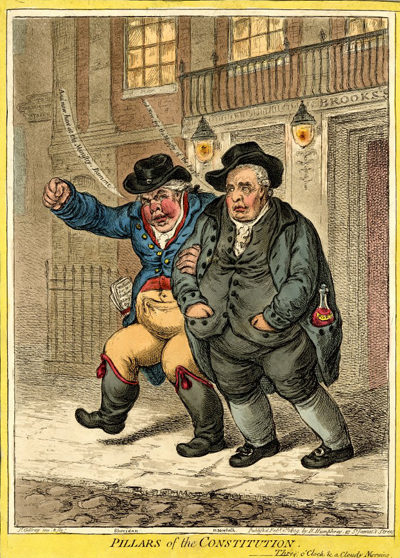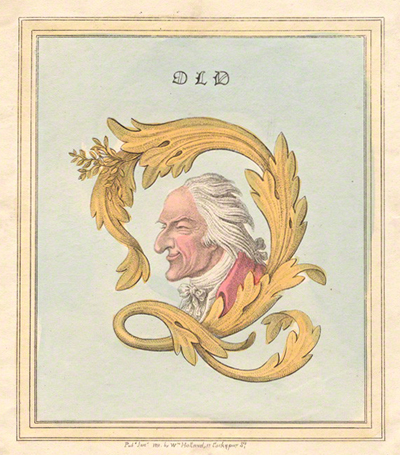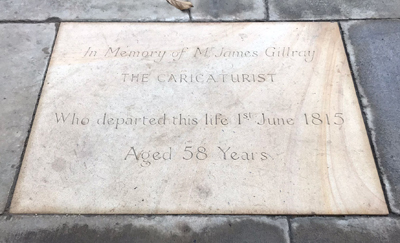Welcome to James Gillray: Caricaturist
Final Years

© Trustees of the British Museum
Gillray's final years were ones of increasing sadness both for Gillray himself and for those who cared about him. According to Draper Hill, Gillray's best student and biographer, Gillray's health began to deteriorate around 1807. He notes that as early as 1795, Gillray had complained to his friend John Sneyd of rheumatism, and by 1807 he "was troubled by poor eyesight", but there is little (at least in Gillray's output) to support this view. The years 1795 to 1799 (with over 275 prints) were, in fact, far and away Gillray's most productive. If he had issues with his hands or joints, it is easier to believe they resulted from overwork. And if his eyesight were an issue after 1807, you would expect to see that reflected in significantly fewer and significantly simpler simpler designs. But that is not the case. There is a slight decline in his output after 1806, but not below levels earlier in his career. And some of Gillray's most elaborate and detailed prints such as Charon's Boat...[1807], A Kick at the Broad Bottoms [1807], Phaeton Alarmed [1808], and The Valley of the Shadow of Death [1808] all appear in 1807 or after, and show no diminution of either conception or execution.
What IS evident from some of Gillray's correspondence is that after 1807 he was producing more slowly and less reliably. He was missing deadlines, and disappointing some of his amateur clients. This suggests perhaps the beginnings of mental rather than physical problems, an inability to focus, to make definitive decisions. Draper Hill suggests that there is more evidence of Gillray relying on preliminary sketches, as if he were afraid to attack the plate without working out every last detail of the design. Gillray had always been moody, according to contemporaries. He is sometimes described as a loner and depressive and at other times as all too excitable. Given the the sometimes frenetic energy on display in the prints, it is easy enough to believe that Gillray may have suffered from manic-depressive or schizophrenic episodes. If indeed his eyesight were deteriorating, this would have provided the kind of additional stress may have further prompted and intensified these episodes.

© National Portrait Gallery, London
In 1810, however, whatever was bothering Gillray now becomes fully evident in his work. His output falls to 17 prints, his lowest since 1786. And there is a corresponding and truly significant drop in quality. There is only one political print, and even some of the social caricatures such as La Walse [1810] The Progress of the Toilet [1810] are wholly lacking in the visual interest and vitality of his characteristic style. And from 1811 to his death in 1815, there are but two works to indicate that Gillray was even still alive.
What is certain, according to Draper Hill, is that sometime around the summer of 1810 he "lapsed into a state of insanity that continued, with only occasional lucid intervals, until his death in June of 1815." During those last five years, he sometimes started prints, but could only seldom retain the concentration to finish them. George Cruikshank visited him during this period and tells the sad story of Gillray insisting that Cruikshank was not Cruikshank and that he was not Gillray but Rubens. One of Gillray's last works was the print old Q [1811] designed in honor of the Duke of Queensberry who had recently passed away. Queensberry had earlier appeared in one of the players in Push-Pin [1797]. The portrait head would have taken Gillray back to the work of his prime, and the elaborate scrollwork of acanthus leaves to form a Q must have recalled his very first job as an engraver of business cards. One hopes it gave him some pleasure.
In late May of 1815, Gillray seems to have made the last of three attempts to kill himself by throwing himself out of an upstairs window. He died few days later on June 1st from the injuries he sustained. He was 58 years old. His recently recreated and rededicated gravestone can be found in the yard before St. James's Church in Picadilly, not far from the locations of Hannah Humphrey's long-departed shops in Bond Street and St James's Street.
THE CARICATURIST
Who departed this life 1st June, 1815,
Aged 58 Years

Photo © Political Cartoon Society